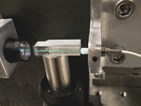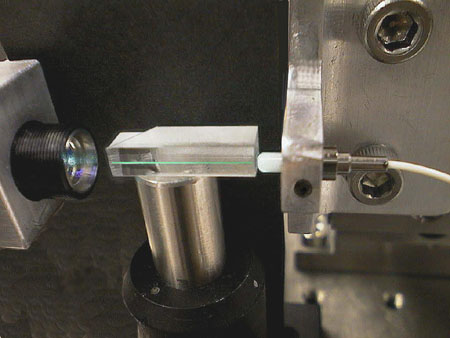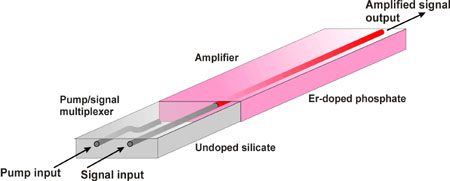EDWA: the new contender for optical amplification

By: Laurie Ann Toupin
Table of Contents
Similarities to EDFAs
Differences and advantages
Applications
Is the need real?
Not a replacement for EDFAs
Erbium-doped waveguide amplifiers (EDWA) are hot this summer. Several recent developments in the technology make EDWAs a viable alternative to erbium-doped fiber amplifiers (EDFAs) when space or finances are limited.
Earlier this year at the Optical Fiber Communications (OFC) conference in March, Teem Photonics (Meylan, France), released the first commercially available EDWA with multiplexer, which uses 140 mW power from a 980-nm laser diode and yields 15 dB of gain and a typical noise figure of 4.5 dB. The saturated output power is 7 dBm at 3-dB gain compression.
Molecular OptoElectronics Corp. (MOEC; Watervliet, New York) debuts its WaveDaemon in September. This C-band waveguide amplifier, using 975-nm pump lasers and based on MOEC's waveguide technology, offers 8 dB of gain in the C-band, with saturated power of more than 15 dBm, making the WaveDaemon suitable for multi-wavelength applications (see Figure 1).

Lucent Technologies' Bell Labs (Murray Hill, New Jersey) announced several breakthroughs at OFC and at the Optical Amplifiers and Their Applications topical meeting (Québec City, Canada) in July for their silicon-based EDWAs. Jean-Marc Delavaux, Joseph Shmulovich, and colleagues demonstrated an erbium-doped planar optical waveguide amplifier with small gain ripple from 1530-1560 nm, using a 1480-nm pump.
EDWAs enable large-scale integration of optical components on a single chip, such as wavelength-division multipliexing (WDM) wavelength routers, multiplexers, or filters, while compensating for passive losses in these components. They are small in size, with a footprint of approximately 30 to 40 mm by 100 mm by 15 mm. Because manufacturers can batch-process wafers and use fewer manual interconnections, EDWAs are also less expensive than EDFAs. "An EDWA may cost you $3,000 or less compared to more than twice as much for an EDFA," says Mike Shimazu, VP of business development at MOEC.
An EDWA operates on the same basic principle as the EDFA, says Jacob Philipsen, project manager for the amplifier development at Teem Photonics. The manufacturers dope a waveguide glass structure with atoms of the rare earth erbium. The system injects the 1.55-m light to be amplified in the waveguide together with pump light at 980 or 1480 nm wavelength. The erbium ions allow energy to be transferred from the pump light to the signal light via absorption of the pump and stimulated emission at the signal wavelength, thus yielding an amplification of the signal light.
Both EDFAs and EDWAs tend to be pumped with the same lasers and have very similar characteristics as far as noise figures and upper state lifetimes and other properties that are important for getting amplification, says Shimazu. The two also have similar wavelength spectra and both amplify multiple channels within the DWDM bands.
The primary difference is in the fabrication of the waveguide amplifier, says Shimazu. EDFAs are made out of a loop of erbium-doped fiber, which is also the gain material. The gain material in waveguide amplifiers takes the form of a much shorter and straighter waveguide built with higher concentrations of erbium, which allows gain at a shorter distance.
Because of how they are processed, passive optical components can be integrated onto the same chip. In conventional EDFAs, one splices the erbium-doped fiber in line with other fiber optic components, says Shimazu. Because one can't splice a waveguide to fiber, MOEC researchers effect the coupling in free space. When the light exits the fiber, it couples into the end of a waveguide. From here, it is amplified and then coupled back into the fiber. During that coupling process, when the light is traversing free space, other components can be added. For example, one can add a free-space optical isolator or pump rather than use a fiber-coupled pump.
This flexibility is important because it reduces cost. "The fiber coupling of such components as isolators or gain flattening filters is an expensive proposition because it requires very fine alignment and expenditures on packaging," Shimazu continues. These can amount to as much as 50% of the final product. "By using free space components instead of fiber-coupled components, waveguide amplifiers can offer a significant cost savings."
Teem Photonics uses ion exchange to integrate components. The ion exchange technology allows the fabrication of waveguide components in glass that is erbium-doped, resulting in EDWAs. Components can also be made in undoped glass, allowing the developer to add splitters or couplers, for example (see Figure 2).

Bell Labs integrates its components yet a third way -- researchers print or etch the components directly onto the wafer.
However it is done, all agree that the benefit of integration is important. Philipsen says, "The more functionality that is integrated on-chip with the amplifying waveguide, the more compact the total amplifier module can be made. This will make it more suitable for mass production, making it more cost-effective." Teem's vision for the future is to integrate the amplifier with functionalities that are not normally present in an amplifier module, such as switch fabrics or arrayed waveguide gratings. Teem already offers an EDWA with a power splitter, resulting in a fully loss-compensated splitter/combiner.
The combiner, a splitter used in the opposite direction, yields a low-cost wavelength multiplexer, says Philipsen.
Another advantage of EDWAs, says Jean-Marc Delavaux, from Bell Labs, is that fiber amplifiers are more dependent on temperature and the environment and require an equalization stage. "Waveguide wafer amplifiers, on the other hand, aren't as sensitive and the equalization is built in." Philipsen adds that EDWAs also have the advantage of intrinsically maintaining polarization.
If you ask researchers at Bell Labs, MOEC, or Teem, there is a definite need for waveguide amplifiers. "At present, there is a strong growth in demand for affordable modest gain amplifiers," says Philipsen, especially for metropolitan area networks. "The shorter fiber spans lead to less losses and therefore a lower gain requirement in the amplifiers," he continues. "In addition, a lower cost per amplifier is required than in long-haul systems."
In its recent survey of the North American market for optical amplifiers in metro/access applications, ElectroniCast Corp. (San Mateo, CA) found that the market in 1999 was $207 million. The company predicts that for the 2000, the market will grow to $269 million. This includes all types of optical amplifiers for various communication metro and access applications.
EDWAs could also be used in transmission systems where the DWDM channels need to be amplified in separate amplifiers. In this application, several waveguides can be stacked on top of the same chip. "Teem markets up to 16 EDWAs on one single chip," says Philipsen, and increasing that number would not be difficult.
As real estate is always at a premium, says Delavaux, one can use waveguide amplifiers as building blocks for complex functions. Waveguide amplifiers can be used to add or drop functions as needed. In conventional amplifier design several stages of amplification are used in between the stages, he explains. Optical add/drop modules, crossconnect module, signal monitoring, and channel equalization devices are inserted between the amplifier stages.
Delavaux adds, "Very often the losses incurred by the function modules require additional amplification stages, which take more space and more equipment, and rely on different technologies that are not always synergistic. The integration of the passive function modules with the waveguide amplification, or a multiplicity of them, is possible with the monolithic erbium waveguide amplifier technology demonstrated by Shmulovich."
Because of their small dimension, erbium waveguides can also be used to make laser cavities (DFB and DBR), ring lasers, short pulse lasers, and optical clocks or oscillators. "As people get more familiar with the technology," Delavaux says, "they will come up with their own ideas on how to apply these amplifiers to their needs."
An ongoing debate rages over the need for such technology. ElectroniCast held conferences in Europe and the US on metro/access networks and participants debated all day on the need for amplification, DWDM, and the proper network system. "When I asked if anyone wanted to continue, 100 people crammed into a little room and discussed this until almost midnight," says Stephen Montgomery, president of ElectroniCast. No definite consensus was reached.
There are pros and cons to both sides. The incumbent local exchange carriers (ILECs) will ultimately answer the question when they decide what they have, what they plan for the future, and how they want to expand the capability of their links, Montgomery continues.
Joseph Lias, executive vice president of marketing, sales, and service for Terawave Communications (Hayward, California), developers optical access products and networks, says that an erbium-doped amplifier is not a viable technology for the first mile optical access application. "In respect to optical access PON [passive optical network] technology, a ‘burst mode' optical amplifier is required. We feel the best optical access amplifier candidate is SOAs [semiconductor optical amplifiers]." However, SOA technology is very expensive and not yet mature, he continues. "We also feel Raman amplifiers, which are fast enough for burst mode transmission, may grow into a viable technology. But the current best approach for PON access applications is a ‘segmented repeater,' Lias says, included as part of Terawave's TeraPON technology suite.
ElectroniCast is currently studying the issue and although they do not have specific numbers yet, Montgomery says, "My take is that there will be a need for amplification someday and that we may have a higher data rate backbone than we have today at OC-192. But the demand will be driven somewhat by the price, as well as the size, how well it meets specs, if the company is well established, and even who field tested the products."
According to Joseph Shmulovich from Lucent Technologies' Bell Laboratories, three issues still need to be addressed before EDWAs are ready for prime time: a coupling problem to standard waveguides and fibers, propagation losses, and reduction in the area occupied by the amplifier.
Generally the mode of an erbium waveguide is smaller than the optical mode size of a fiber, says Delavaux. In packaging the waveguide with input and output fiber one has to make sure that a good mode matching transition reduces the coupling losses at the interface. In the design of the amplifier there is a trade off between doping level and propagation losses. More erbium ions gives more signal gain, but also produces more pump requirement and signal scattering caused by the ion level and waveguide geometry. Lower erbium concentration leads to less gain per cm (unit length) and requires the waveguide to be a certain length to achieve a certain gain level. A long waveguide length, such as 0.5 m, may occupy a lot of wafer space and become difficult to fabricate.
Philipsen disagrees. "I don't see these issues as major challenges for Teem's technology as we already have good coupling and low propagation losses," he says. "The major challenge I see is in rapidly increasing the level of integration."
"While I don't think waveguide amplifiers will ever displace existing EDFA technology in their most established applications," says Shimazu from MOEC, "I think they will be useful in certain areas such as metro networks and access networks."
About the author…
Laurie Ann Toupin is a freelance writer based in Massachusetts.
